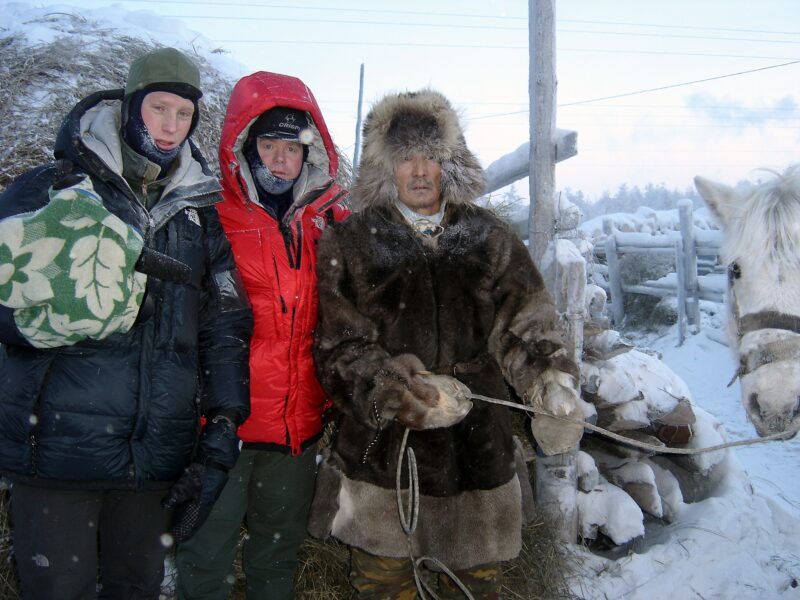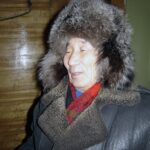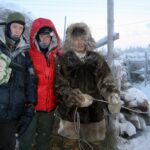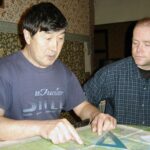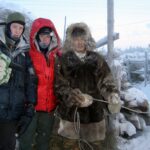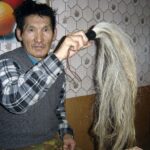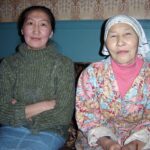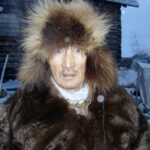20 YEARS SINCE THE SIBERIAN EXPEDITION: Conversations about the KGB and Stalin’s Gulags with Nikolai Vadimovich
New ski boots arrived today from Yakutsk, the 7th of January 2004, as did bindings, tent poles and 30 DVD films. Marvelous! It’s still extremely cold, -56°F, the darkness is continuing to penetrate every corner of our lives and Srednekolymsk.
“I remember when I was a young boy” , Nikolai Vadimovich said, ”and I was standing down by the river, when a boat arrived. It was full of convicts and soldiers. The soldiers embarked quickly and formed a ring. A soldier in charge shouted to the convicts to get of the boat and if anybody would step out of the ring, he would be punished. One big convict ignored the warning and he got knocked down immediately. A rifle hit at the back of his head. That was the way peopled got punished in those days.”
We were sitting at the kitchen table belonging to the mayor of the little village called Oyondarnahk, as usual, listening intensely to what Nikolai Vadimovich had to say. He retired a few years back after being deputy major of Srednekolymsk for ten years. Before that he had been major himself during the Soviet era and spent another ten years during that era being deputy under the present mayor, Mr. Grigorjev. He’s one of these humble humans who’ve seen, heard and understood most things of life. Very wise, intelligent and easy going. A joy to spend a few hours listening to. He doesn’t judge, he listens and enjoys sharing his experiences and knowledge with others.
“The ruins after the Gulag which existed here” , he continued, “are located just a few kilometers outside of Srednekolymsk. I remember passing it in a boat when I was a kid and a saw a lot of barracks surrounded by a fence of barbed wire. Stern soldiers patrolled the area. We were told that the prisoners were criminals.”
Everyone, without no exceptions, that we’ve come across along the Kolyma, with their own experience from the time of Stalin’s gulags, have said that nobody knew what was going on. One didn’t talk about it. And everybody thought that the convicts were simple criminals.
“Than perestroika arrived” , Nikolai Vadimovich continued, “and we got besieged by terrible information about the Gulags. Of course we got utterly shocked! But, still, I think there also should be said that it is important to try to find a true balance in all the revelations turning up about those dreadful years. I am not defending the atrocities, but everybody believes that 99% of all convicts were innocent political prisoners, but this is not the truth. There were plenty of the worst kind of criminals as well. And all camps were not like the one in Ambarchik Bay, a place you entered but never left again. Take this camp outside of Srednekolymsk for example, there were several levels of prisoners and some of them were considered not so dangerous and could even move around as they liked within the limit of this settlement. And other settlements along the Kolyma. Some of them were pioneers and started schools and hospitals and ended up being revered after their death. Some even stayed after the death of Stalin, when the history of the camps ended.”
As usual, we eventually ended up talking about the time before and after perestroika. Both Nikolai Vadimovich and the mayor of Oyondarnahk pointed out all the well-known problems which had arisen due to the fast change, but, both also noted, contrary to the normal opinions we’ve heard, that there were also plenty of positive aspects with the change. They even believed that there were more positive times coming up ahead. I told them, as I always do, about the general simplified image that we Swedes were fed regarding the times of the Soviet union, before the perestroika hit this vast land. I told them about a bleak, depressing picture of utterly serious people who were run by scrupulous dictator’s waving stone faced from the walls of the Kremlin. I told them about the deadly KGB and that we figured all Russians spent all days waiting in long queues to buy bread. And, it was almost impossible for a traveler to enter this vast land.
“One of the very positive aspects with perestroika” , Nikolai Vadimovich continued, “is the fact that borders are open for everybody to come.”
I told them about how difficult, how extremely costly and time-consuming it had been for us to be able to get the privilege to travel the Kolyma. Whether it is post-perestroika or not.
“Well”, Nikolai Vadimovich said, “even though perestroika took place years ago, it still hasn’t arrived fully to Srednekolymsk.”
“But, what about the KGB during the Soviet Era here in Srednekolymsk” , I asked, “did they track down, harass and imprison non-believers, did they use snitches and did they turn up at peoples doors in the middle of the night, taking them away and were people terrified to death by their presence?”
“You must have read that in a book” ,they both answered at the same time, “it wasn’t like that at all. A state needs a security police, there’s no doubt about that. This applies to all countries. And regarding the KGB in Srednekolymsk, they did exist, but you never saw them. At times a KGB officer from Moscow came for a visit, checked things for a few days and than left. That’s it.”
They told my exactly the same things that I was told in Zyryanka. A bit of a disappointment, of course, after having read an enormous amount of exiting books and seen a number of thrillers from Hollywood which has involved the most dangerous of KGB-agents! Seriously, my opinion is that it was people in the big cities in the west, which suffered the most of all the negative aspects which came with the Soviet Era. Total control, the great worry about spies, the danger for people with different opinions and the internal narrow-mindedness. This is probably also the reason why so many along the Kolyma talk so positively about the Soviet era.
“But, it’s definitely very nice to meet people from other countries” , Nikolai Vadimovich laughed, “ you’re not like we thought either!”
